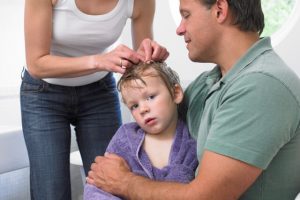7 Tips for Preventing and Dealing with Lice

Going back to school means picking up routines and habits long forgotten over the summer. And the beginning of the school year can also bring less pleasant experiences, such as lice.
Here are 7 tips for preventing and dealing with lice.
What do you know about lice?
Lice are insects without wings that live in human hair. They are more frequent in children.
These insects feed on small quantities of blood, several times a day. This explains why they are so bothersome – their bites make you itch.
If the affected individual scratches too much, the skin may become irritated, causing wounds and even infection.
Furthermore, lice are very contagious. They can pass from one person’s head to another quite easily. Lice survive for up to 30 days on the human head and can lay up to 8 eggs per day.
Given that lice reproduce so quickly, it’s best to treat them as quickly as possible.
“Lice are not gross… What’s their purpose on the planet? To keep us humble, of course, and to remind us to slow down and take a good look at our kids.”
-Beth Berry-
7 Tips to keep your child from getting lice
1. Information from your child’s school
When your kid’s school warns you of the existence of lice, it’s time to pull out the fine-tooth comb. Carefully comb through your child’s hair everyday after school to eliminate possible lice or eggs.
In the same way, it’s also important that you let your child’s school know if you discover that your child has lice. This will help keep the epidemic from spreading to all the other children in your son or daughter’s class.
By routinely checking your child’s scalp, you can quickly detect and eliminate any lice or nits. Catching the problem early on will keep the lice from forming a nest in your little one’s hair, or reproducing to the point of infestation.
The best way to go about this inspection is dividing your child’s hair into 4 sections. Carefully and slowly inspect each section with a fine-tooth comb.
For best results, use a special metallic comb, called a nit comb, that is created specifically for removing lice and their eggs.
2. No sharing
It’s very important that your child does not share combs, hats or hair accessories with other children. Lice don’t fly, nor do they jump from one head to the other. Rather, they grab onto hair and crawl quickly from one head to the other.
3. Vinegar
Vinegar is a great ally when it comes to preventing lice. Rinse your child’s head in a mix of equal parts of vinegar and warm water.
Don’t rinse out the vinegar. Rather, allow it take effect. The vinegar will help remove any nits that have managed to stay stuck on your child’s hair even after you’ve gone over it with a fine-tooth comb.
4. Tea tree oil
Tea tree oil is one of the best natural remedies that exists for preventing lice.
Tea tree helps to get rid of lice in a completely natural way. To treat your little one’s lice, dilute 10 drops of tea tree oil in 60 ml of water. Pour the mixture into a spray bottle.
Shake the solution well and spray it evenly over your child’s hair. Focus especially around the neck and behind the ears, making sure to soak these areas.
Then cover your child’s hear with a shower cap and allow the spray to work for 30 minutes. The tea tree will loosen the nits in your child’s hair, making it very easy to remove them with a metallic nit comb.
5. Lavender
6. Rosemary
The scent of this plant serves to repel lice. Simply add a few drops to your child’s shampoo. Massage the shampoo solution into your child’s hair and scalp and leave for 30 minutes. Rinse well.
When using rosemary oil, or any other essential oil, be careful to avoid getting it in your child’s eyes.
7. Pharmaceutical products
You’ll be able to find a wide variety of lice shampoos, creams and foams at your local pharmacy.
All of these products should be applied to dry hair with gentle massage. Make sure to carefully follow the product’s instructions.
These products are usually very effective. However, you will usually need to repeat the treatment after several days to completely eradicate the problem.
This text is provided for informational purposes only and does not replace consultation with a professional. If in doubt, consult your specialist.








